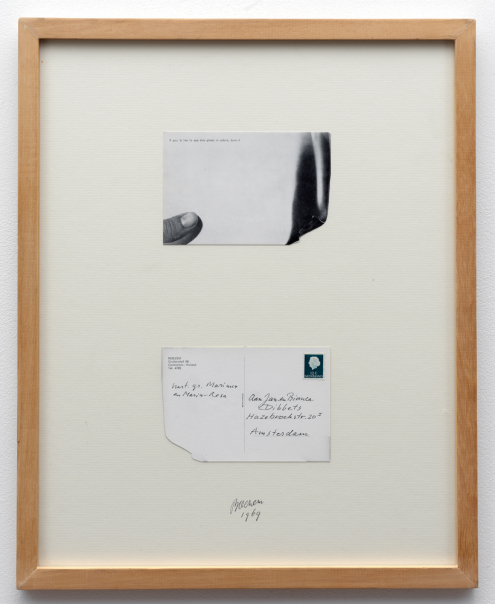Marinus Boezem at Japanese Society Gallery in New York

Marinus Boezem at Japanese Society Gallery in New York
Marinus Boezem’s “If you’d like to see this photo in colors, burn it” (1967-69) features in the exhibition Radicalism in the Wilderness: Japanese Artists in the Global 1960s at Japan Society Gallery in New York until June 9. In the late sixties, early seventies Marinus Boezem shared his ideas and artworks with the Japanese artist Matsuzawa Yutaka (1922-2006), who was the founder of the conceptualist art movement in Japan. Boezem’s photo was sent as a card to Yutaka as part of his mail art project. A large share of Yutaka’s estate is now on show at the Japan Society Gallery, including Boezem’s card.
Radicalism in the Wilderness
The exhibition introduces the radical experiments of three artists in 1960s Japan, who made groundbreaking contributions to the development of international postwar art in defiance of existing conventions of art-making, and who were directly connected to and produced work that resonated with various other global practitioners. These hitherto little known artists—Matsuzawa Yutaka and two collectives The Play and GUN—challenged established norms to expand the definition of “visual art” through language, performance, mail art, land art, and political art. Their conceptualist projects—at times colorful, imaginative, and playful—were nonetheless inextricably informed by complex social, political, cultural issues of the time, including the Apollo Space Program and the Vietnam War. Taken together, their artistic and social engagements resonate with global tendencies of 1960s art.
The exhibition is curated by Reiko Tomii, a New York-based independent scholar and curator, in collaboration with Yukie Kamiya, Director, Japan Society Gallery. Based on Tomii’s award-winning book Radicalism in the Wilderness: International Contemporaneity and 1960s Art in Japan (MIT Press, 2016), the exhibition will draw extensively from institutional and private holdings as well as the artists’ personal collections to offer an in- depth look into these key artists of 1960s Japan, highlighting their engagements with the wilderness.
Studying these practitioners’ imaginative and innovative works, the exhibition will explore many aspects of the “wilderness.” While the wilderness literally means remote landscapes from the urban centers, it conceptually and strategically embodies art “out there.” In a theoretical context, “out there” meant outside of the conventional norm of thinking, as exemplified by their radical experimentalism. In a larger context, “out there” meant outside of the mainstream of contemporary art, as embodied by such widely known movements as Gutai and Mono-ha. For instance, for The Play, the wilderness was the destination of their voyages that at once departed from the conventional artmaking and located outside of the institution of art. These practitioners conceptualized the local to overcome distance and managed to connect with the global by creating works that resonated with contemporary practices, including that of Kawara On, Kusama Yayoi, along with Marinus Boezem, Gilbert & George, Robert Smithson, Robert Barry, Lawrence Weiner, Stanley Brouwn, and Yoko Ono.
if you'd like to see this photo in colors, burn it
"The work takes the form of a black and white picture postcard with Boezem's address on the back. In the left corner of the front, Boezem's thumb is pictured life-sized, as if he is holding the card. On the right side, the depiction of a curling sheet of paper creates the impression that the card is going up in flames. The card is printed in black and white. On the upper left edge is the instruction: "if you'd like to see this photo in colors, burn it.' In 1969 the card was sent by mail to 200 persons as an artwork. The recipient is involved as a co-actor in the creation of the intended artwork, by holding it in the spot where Boezem's thumb is pictured and then lighting it on fire. By this intervention, the black and white photograph of the flames is temporarily transformed into the color of real flames. At the same time, the realization of the artwork means its destruction. The card disintegrates into black ash. Because the recipient holds the card in the spot where the picture of Boezem's thumb is located, the illusion of reality in a certain sense turns back into reality. With a normal picture postcard, the process runs the opposite direction. The work has connections with Paper Events, 1970, and I invite you to make love on February 11th, 1978, at 22:00 hours, in which the artwork only in fact exists through the intervention of the viewer." (Witteveen, 210 [96], Catalogue Raissoné)
Image: Marinus Boezem, “If you’d like to see this photo in colors, burn it” (1967-69), ink, offset, 10,8 x 16 cm, photo: Gert Jan van Rooij.
Publication date: 10 May '19
